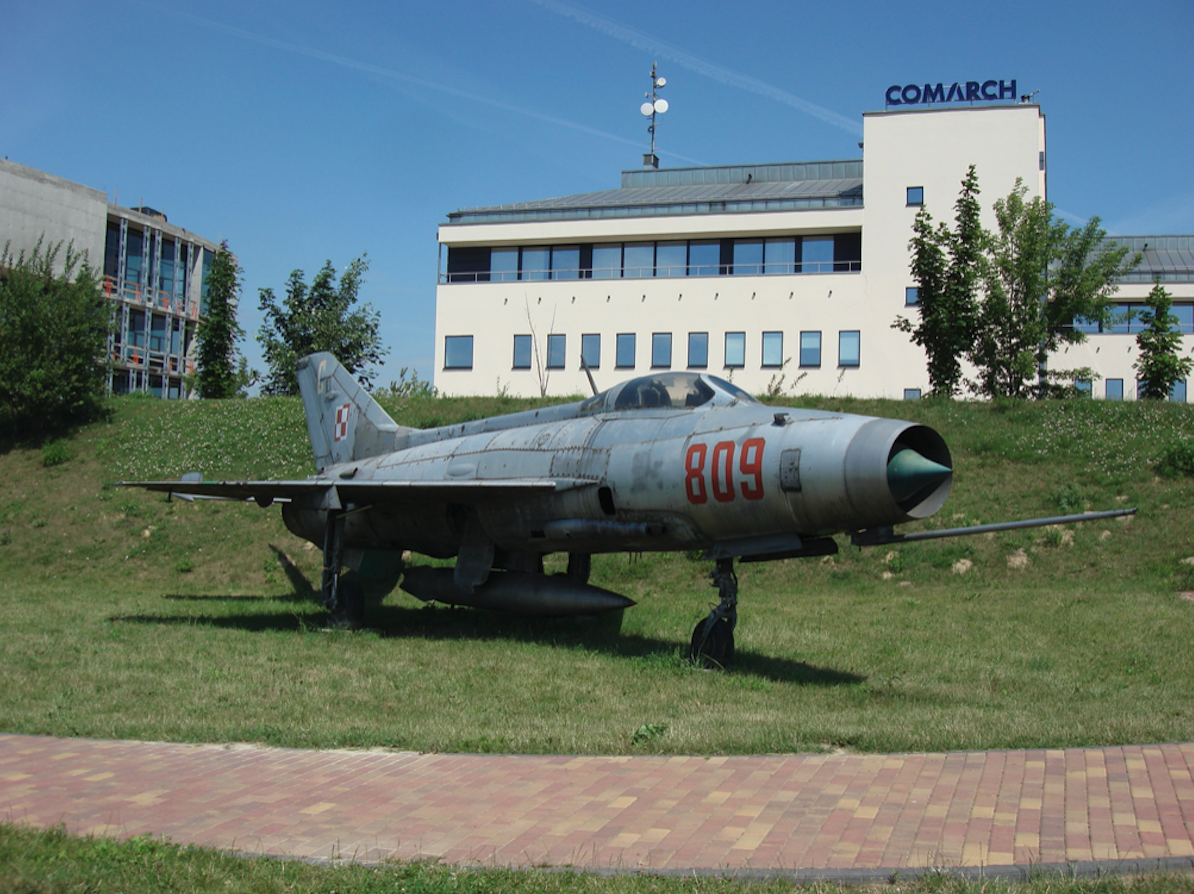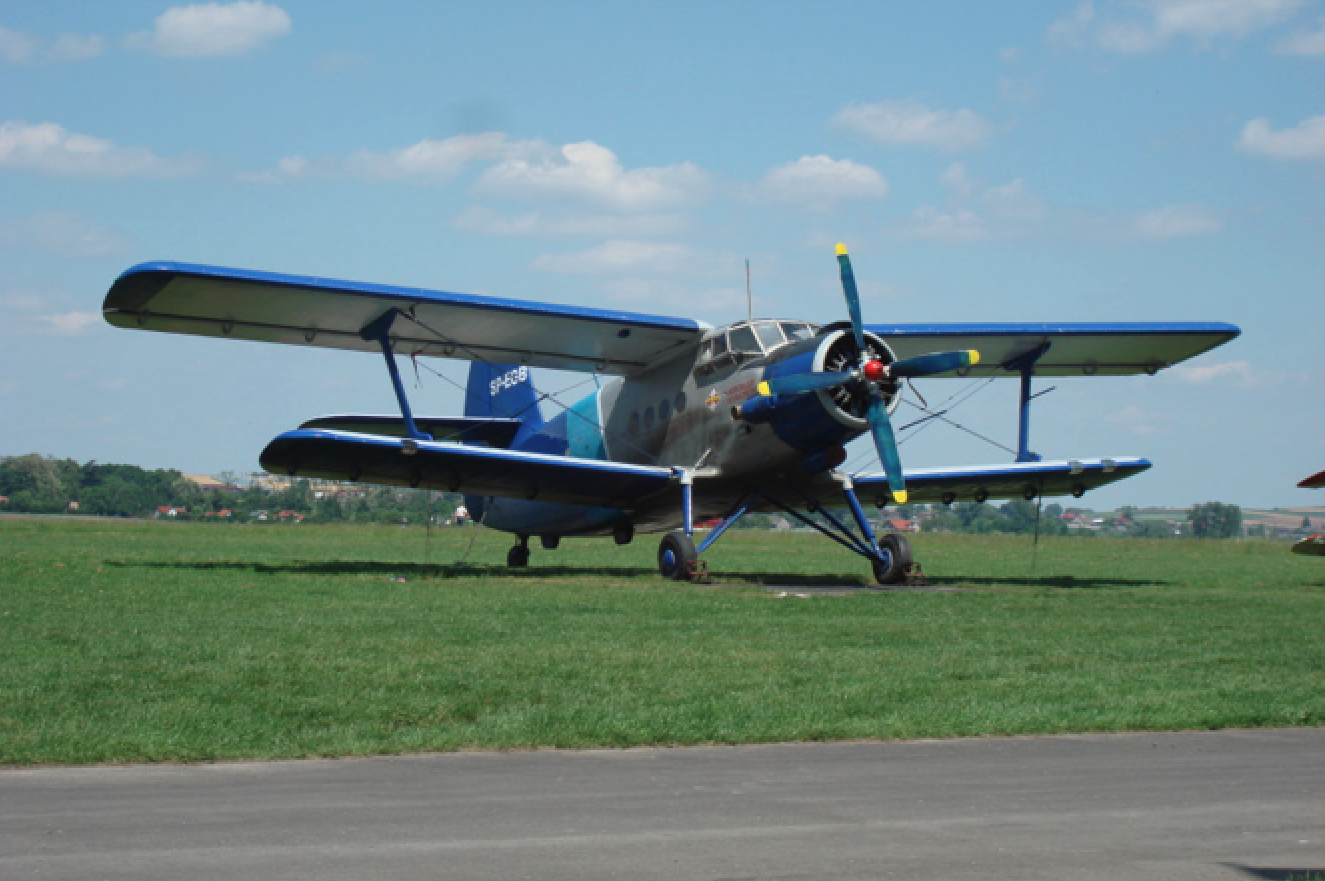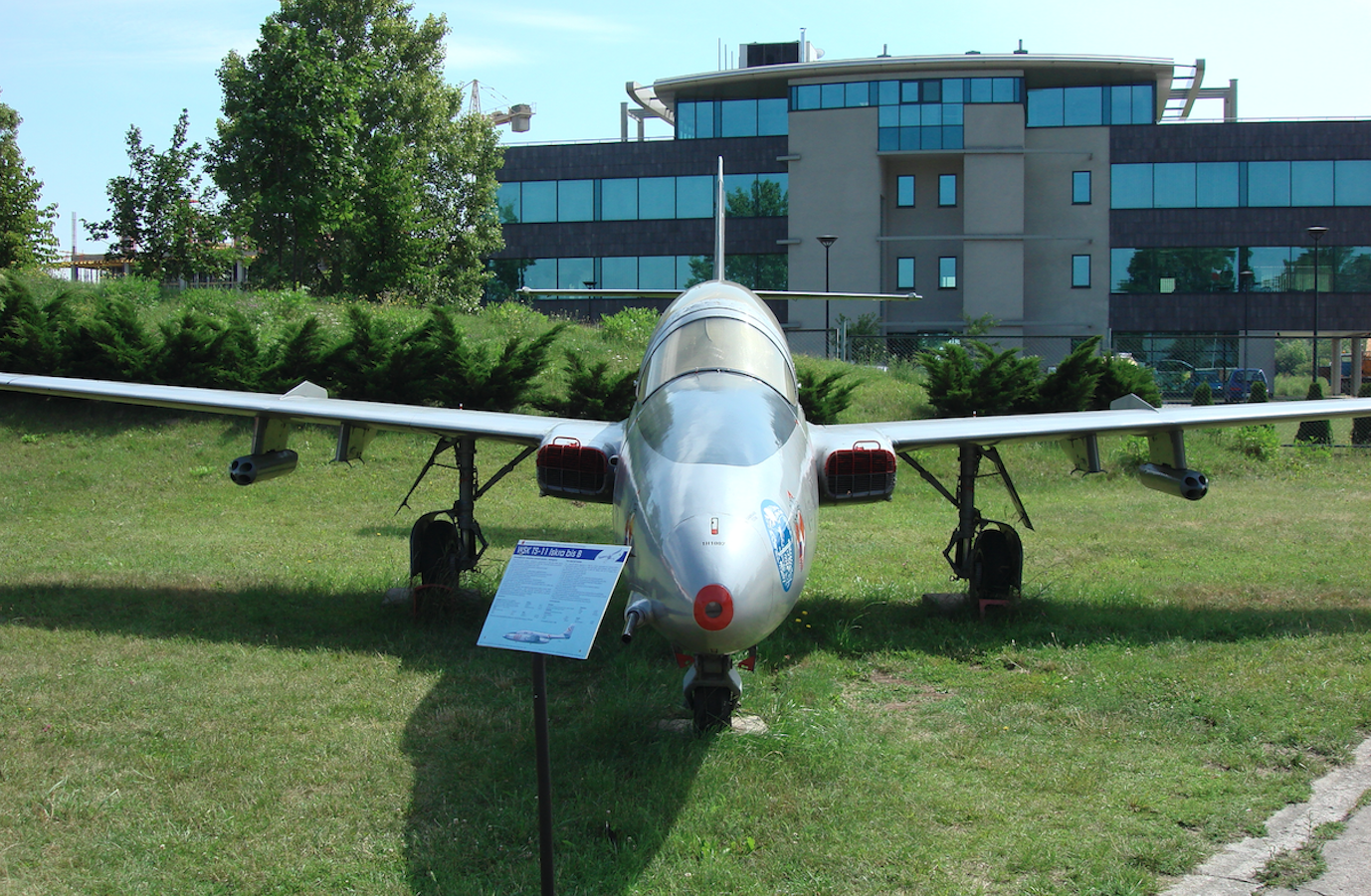Poznań 2012-10-20
The airport in Krzesiny near Poznań.
Geographic coordinates: 52.333N 16.963E.
To be continued.
1962.
In the spring of 1962, due to the change of the National Air Force and Air Defense Forces to the National Air Defense Forces, the name of the Regiment was also changed to the 62nd PLM OPK. It happened in March 1963.
MiG-21 in the 62nd PLM. 1963.
Already in November 1962, it was known that the Regiment would receive MiG-21 F-13 fighters as supersonic equipment. In 1963, new MiG-21 F-13 fighters were adopted at the 62nd PLM status, and in 1964, the first MiG-21 PF. The regiment was the first combat unit to be equipped with this type of aircraft.

1964.
In 1964, the first An-2 transport and liaison planes were introduced to the status of the 62nd Regiment. The first one was used back in 2002, and it was taken out of service in 2005.

In May 1966, the unit was transferred to the airport in Babimost, due to the renovation and renovation of the airport in Krzesiny. The next comprehensive renovation of the airport was carried out in 1973 and 1985. During the repairs, among others, earth embankments for airplanes, bunkers for squadrons and command posts were made.
In June 1966, the 62nd Regiment participated in exercises of the Warsaw Pact, in which it made landings and take-offs from the Dol (on the highway) for the first time.
In 1967, the 62nd Regiment adopted the first training and combat planes of the MiG-21 U type.
Despite the introduction of new versions of supersonic aircraft into service, the 62nd Regiment continued to use Lim-5 aircraft, which were equipped with the 3rd Squadron. This was the case when the first MiG-21 PFM fighters arrived in Krzesin in 1970. The new MiG-21 PFM was used until 1998.

In 1971, MiG-21 US training and combat planes were introduced to the armament of the unit in Krzesiny. In November 1973, the 62nd Regiment was once again reformed. From a three-squadron job, the unit moved to a two-squadron job. Two Air Squadrons were created; 1. Squadron on MiG-21 planes, 2. Squadron on Lim-5 planes, which remained in service until 1981, when the squadron received further MiG-21 PFM planes. The new organization functioned from December 1, 1973.
Also in 1973, another renovation of the airport in Poznańskie Krzesiny was carried out. The regiment was transported to Mierzęcice and to the Kąkolewo backup airport near Grodzisk Wielkopolski, where it stayed for almost half a year.
In 1975, on the initiative of Col. Rejewski, the regiment's badge was designed, referring to the pre-war traditions of Poznań aviation units, showing the image of a raven stylized in the shape of a jet plane.
In 1975, the 62nd Regiment adopted two new types of aircraft. The first was the training and combat TS-11 Iskra bis DF. The second light liaison plane PZL-104 Wilga 35.

1980.
In 1980 and 1985, the 62nd Regiment made another ferry to the airport in Babimost, and for the time of renovation and modernization of the home airport, it was carried out. In addition to the overhaul of the runway and taxiways, shelters for MiG-21 planes were built near the RWY and were used until 2000.
In March 1981, the operation of the PZL Lim-5 and PZL SB Lim-2 aircraft was completed.
At the end of the 80's, military aviation was restructured. The Air Force and the National Air Defense Forces were merged into the Air and Air Defense Forces. The command of the new structure was located in Warsaw. At that time, Poland withdrew from the Warsaw Pact, which only existed fictionally. 62 PLM still remained in the structure of the 3rd PEC in Wrocław. Despite the change in Poland's defense doctrine, the tasks of the 62nd PLM have not changed. The regiment continued to defend the air area of Wielkopolska, and especially the industrialized Poznań region, in cooperation with missile squadrons, mainly with the 79th Rocket Regiment of the Polish Air Defense. The basic aircraft was still the MiG-21 PFM.
1990.
On May 3, 1991, during the ceremony in front of the Tomb of the Unknown Soldier in Warsaw. the 62nd PLM was handed over the banner of the Greater Poland Aeronautical Brigade of the Greater Poland Army and the heritage of the tradition of Greater Poland air squadrons. The event was organized on the occasion of the 200th anniversary of the May 3rd Constitution.
In August 1991, at the Ławica airport, an international aviation event was organized under the name "Air Show". The logistics base and the center of the aircraft grouping were the 62nd PLM and the Krzesiny airport. At the airport in Krzesiny, combat planes from the West were based; F-15, F-16, Mirage 2000, Tornado GR. It was the first such aviation event in the history of Poland and all of Eastern Europe.
3rd Fighter Aviation Regiment. 1994.
In 1994, on the 40th anniversary of the establishment of the unit, efforts were made to change the name of the regiment. On the basis of the decision of the Minister of National Defense of January 16, 1995, the Regiment changed the number "62" to "3" and received the distinguishing name "POZNAŃ". He took over the heritage of the fighter squadrons of the 2nd and 4th Wielkopolska Aviation Squadrons and the fighter squadrons from 1921-1939, from the composition of the 3rd Air Regiment in Poznań, and the 2nd Kraków-Poznań Fighter Squadron in France and the 302nd Fighter Squadron "Poznański" in Great Britain.
In 1995, the circle of former professional soldiers, institutions, workplaces and private companies funded the unit with a banner, and the award ceremony took place on the eve of the Regiment's holiday, which was celebrated on September 4. It is a memento of the day on which the order to form the unit was issued.
In 1994, the planned spatial development plan envisaged the transformation of the military airport in Krzesiny into a civil airport with a zone of intense economic development around. Such a transformation was to be facilitated by the location of the airport. However, this did not happen. The Military Aviation did not intend to give up this facility. Not only that, in the following years it transformed it into a modern base. Therefore, since 2001, no permits have been issued for the construction of new residential houses in the area.
In September 1997, the 3rd PLM participated in the Polish-American exercise "Orli Szpon" (Eagles Talon). The Poznań airport was in the territory of "Pyrlandia", which covers Wielkopolska. The "Blue" forces were stationed here, that is: 606 Control and Command Squadron from the 52TFW base in Spangdahlem and fighter planes with 1, 9 and 28 PLMs.
In 1997, the 3rd PLM received MiG-21 R and MiG-21 UM planes from the disbanded 32nd PLRT in Sochaczew. After being adapted to hunting tasks, they were included in the armament of the Regiment alongside the MiG-21 PFM aircraft. On March 27, 1998, the MiG-21 PFM planes were officially withdrawn from service, and MiG-21 R and MiG-21 MF from the disbanded regiments in Sochaczew and Wrocław were replaced.
In 1998, the 3rd Regiment won the Military Commander's Cup for achievements in the field of flight safety. It was the third such award for the 3rd PLM. The ceremony took place on January 28, 1998, during the 40th Flight Safety Conference. After the dismantling of the 17th Air Force Squadron from Poznańska Ławica in March 1999, some of the flying and technical personnel, along with the PZL Mi-2 helicopters, were included in the 1st Squadron of the 3rd PLM. Apart from transport and liaison tasks, to this day (2010) the helicopter key is on duty all year round as part of the Polish Air Search and Rescue System "ASAR".
In May 1999, the "Ocelot 99" exercise took place with the participation of the 3rd PLM. Designated planes from the "red" forces - Southlandia MiG-21 MF and MiG-21 R served as airplanes violating the no-fly zone and were intercepted by the forces of the International Air Wing stationed at the airport in Powidz.
On September 4, 1999, a ceremony was held for the 45th anniversary of the Regiment.
2000.
On March 24, 2000, Tornado GR.4 planes from 9 Squadron RAF stationed in Bruggen, Germany were stationed at the airport in Poznańskie Krzesiny. Tornado planes flew to Poznań to make a ceremonial flight over the Poznań Citadel in tribute to the pilots of the 9th RAF Bomber Squadron buried in the British Commonwealth Cemetery, shot after escaping from the Stalag Luft III POW camp in Żagań in 1944.
On December 31, 2000, the 3rd PLM was transformed into the 31st Air Base and the 3rd Tactical Aviation Squadron. The changes were based on the decision of the Minister of National Defense of October 3, 2000. On December 29, 2000, the solemn ceremony of dissolving the 3rd Poznań Fighter Aviation Regiment was held at the airport in Krzesiny. From January 1, 2001, two units started operating at the Krzesiny Airport; 31st Air Base and 3rd Tactical Aviation Squadron. 31. BLot was tasked with securing the operation of the aviation component, namely the 3rd ELT. Its first commander was Colonel certified pilot Antoni Masłowski, who since 1993 commanded the 62nd PLM, transformed in 1995 into the 3rd PLM. 3. ELT had MiG-21 MF, MiG-21 R (adapted for hunting tasks) and MiG-21 UM fighters in service at that time. The structure also included search and rescue helicopters.
In May 2001, the 3rd ELT was transferred to Łask Airport so that the modernization of RWY and DK could be started. On July 12, 2002, the main work on the take-off field was completed, which allowed the return of the 3rd ELT to the home airport and continued combat duty under the NATO Integrated Air Defense System.
In 2003, the decision of the Ministry of National Defense was made to withdraw all other MiG-21 combat aircraft from service. Polish aviation was left with the MiG-29 combat fighters and the Su-22 attack fighters. In order to maintain the piloting habits of the 3rd ELT, it was equipped with the training TS-11 Iskra.
Written by Karol Placha Hetman
To be continued.
